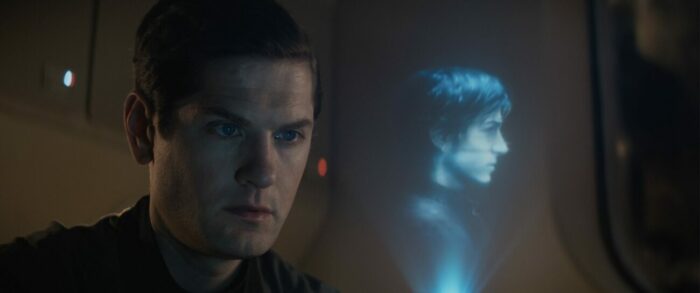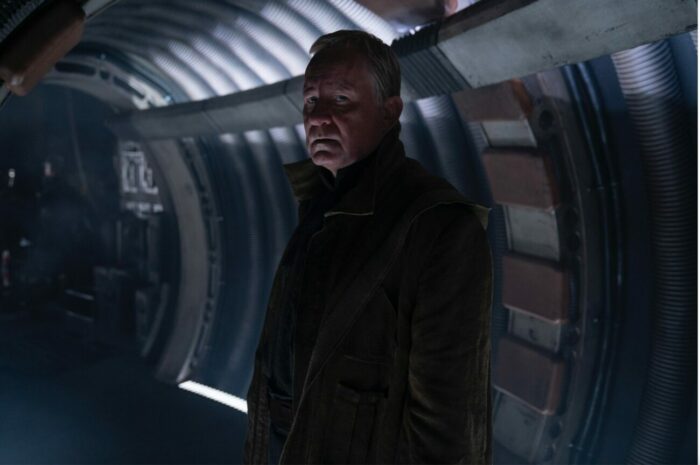Now until the end of day, the sentiment remains from George Lucas that Star Wars is made for twelve-year-olds. As time moves forward, however, those twelve-year-olds become adults. As adults, many of us can cling to childish things without the ability to move on to more mature material. But I question if Star Wars has to be marketed towards kids indefinitely. For decades that was the case. Despite all the piles of dead children Darth Vader leaves beside his feet, the overall vibe Star Wars gives out is youthful. Finally, someone in the writing department recognizes the maturity and intelligence of an audience who grew up with Star Wars.
In Tony Gilroy, I trust. At least until a few episodes down the line when everything connects to the Death Star. The showrunner for Disney+’s Andor understands that it’s okay for adults to like Star Wars. Beyond the toyetic-ness of the Star Wars universe, Gilroy gets there’s an entire galaxy populated by people who have incredibly complicated lives. The modus operandi of Star Wars has been a clear cut set of ideals between good and evil. Rebels good, Empire bad. Certainly, Dave Filoni blended the line of moral composition with the Jedi’s hypocrisy in The Clone Wars. But that was between endless firefights to keep the children’s attention from wandering off. Tony Gilroy’s Andor isn’t drowned in endless action or absolutes. Instead, it deals with the gray area of heroism where Gilroy bothers to ask if our heroes are as good as they seem.

Andor’s introduction in Rogue One seemed out of character for a hero. After receiving information about the Death Star from an informant, Cassian Andor (Diego Luna) shoots the spy in cold blood. Why Cassian’s so barbarically natured is examined upfront in Andor. The show opens on the rain-soaked streets of a corporate-owned planet. Judging by how run down everything is, the Premo Corporation is only a step below the Empire regarding civilian cruelty. After a scuffle with some local drunks goes awry, Cassian’s life gets put in a tailspin, setting forth his destiny.
If you thought Cassian blasting the Death Star informant was harsh, wait til you see what Cassian is capable of in this series. Many don’t want anything to do with him. Cassian’s a lost man who leans into his primordial tendencies as a method of survival, causing relationships to be limited or strained. Raised in a tough background, Cassian had to learn to fight to survive, but has it made him a psychopath? Gilroy explores the moral complexities of a character who’s neither hero nor a villain. He’s simply a man trying to survive in a police-controlled galaxy.
Without spoiling the show, the series antagonist Sergeant Mosk (Alex Ferns) isn’t a clear-cut bad guy. Like Cassian, it’s questionable whether he’s correct in his actions or ethically confused. Mosk presents a different side of things from a “bad guy’s” perspective never been explored before in Star Wars. At least in a big-budget live-action property. The man hunting Cassian aims to do the right thing, yet the cost of doing so may be harsher than necessary. Or is it?
The characters in Andor have more depth than the typical knight in shining armor fighting against the imperialism that suffocates democracy. As a defender of the politics of the prequels, I love the world-building Mr. Gilroy constructs in Andor. I understand if you hated the politics in the prequels. By all accounts, they can be as thrilling as C-Span. To calm your worries, I can assure you that the politics in the show are far more dynamic than the prequel’s bureaucratic jargon, focusing on the effects policy has on everyday inhabitants’ lives.
Where Star Wars often cuts to a Stormtrooper torching a local village or a Star Destroyer exterminating a planet, Andor gives you a sense of the Empire’s smaller effects on the Galaxy. This is especially accentuated though Luke Hull’s stellar production design. Where Star Wars‘ recent projects have had an over-reliance on 3D animated sets, Andor’s backdrops are almost entirely on camera, thanks to a vastly reduced scale. Built by hand, the backdrop has a physicality that’s a breath of fresh air. You can almost smell the gravel and leftover chunks of metal scattered across the war-torn universe.
Andor looks more like Blade Runner than Star Wars. The reign of the Empire has affected the well-being of the Galaxy’s inhabitants. That classic dirty look from the original trilogy era leans towards Andor’s favor. The thirty-some odd year span between Revenge of The Sith and Star Wars 1977 (I’m a purist) has been rough. The clean, spotless environments from the prequels are replaced with a dirt-filled galaxy that looks like a trashy village in a used planet from the future. The physical sets Mr. Britell’s team has built are a loving homage to the classic Star Wars films by using the setpieces as a pretty background and a metaphor for Andor’s struggling cast of characters.
Practicing patience like a Jedi, Andor moves at a methodical pace, with each episode adding a layer to Cassian and those who come to his aid. Bix Caleen (Adria Arjona) is Andor’s strained relationship side, while Luthen Rael (Stellan Skarsgard) represents Cas’ angry side. With only one legacy character, some layers are added to Mon Mothma (Genevieve O’Reilly), which paints her motivation for joining the Rebellion much more clearly.

Having been nominated for writing and directing Michael Clayton and penning The Bourne Identity trilogy, Tony Gilroy is the type of screenwriter who knows the action/thriller genre. The element that’s worked in Clayton and Bourne was its focus on building an exciting cast of characters. Andor, by all accounts, is a character-centered thriller about belonging. So far, the series has not cheapened up on surprise cameos from a Skywalker, Fett, or Solo. During Rogue One’s famed reshoots, Mr. Gilroy came on board to rewrite much of the script. Judging by the Godzilla director (Gareth Edwards) resume, Lucasfilm may have decided the picture needed more depth or motivation for its lead characters. Studio interference can sometimes be a good thing if that’s the case. Of course, too much interference can lead to nightmares like The Rise of Skywalker, while too little interference gives you The Last Jedi.
Through Tony Gilroy’s writing, aided by his brother Dan, Beau Willimon, and Stephen Schiff, Star Wars finally does what it should have for a while. Take its time. George Lucas isn’t the best writer in the world. The people Disney has hired haven’t been great either (minus The Mandalorian team). But these guys get it. Star Wars is a universe that doesn’t just need to be constant action. Episodes I-III tried to prove that point but leaned toward children. Andor does away with the childlike elements of Star Wars, focusing on a more mature story dealing with strained romantic relationships, economic disparity, and tribalism.
Instead of having another rescue mission, Andor examines Cassian’s background, the people in his life, and why a nobody in the Galaxy can become somebody without feeling trite. Four episodes into the show, things begin to seem familiar. Can you say infiltration mission? If Star Wars has a fallback option, it’s teddy bears and children; the other is missions consisting of sneaking into an imperial facility, getting caught, then everyone having to blast their way out. Seeing that this is a show about the Rebellion, it only makes sense that the structure would shift towards the usual rebellious things we’re used to seeing the Rebels do. Shoot bad guys, sneak into enemy bases, and blow things up.
Judging by Andor, Gilroy may have saved Rogue One from becoming a soulless nostalgia grab. If the show continues on its wise course of character over action, Andor can be/currently is a step in the right direction. Despite all this praise, with four episodes to go, there is a lingering dread of predictability. For as interesting as Cassian Andor is, we know how he dies. We also know how Obi-Wan perishes, as well as the Clones. We know Cassian will join the Rebellion, and we know he will be eviscerated on Scarif. Aside from the slower pace, I can imagine the story getting boring reasonably quickly if the show becomes another steal from or kill the bad guys sequence of events. Here’s hoping Andor’s cast continues to have more meat to chew on the tauntaun’s bones before running dry on nuance.


Andor. Like what I’ve been wanting but not knowing I wanted it. It’s dark. It’s deep and nothing I expected from Disney. Enjoy knowing more about these characters souls and their personal pursuits. Damn the Empire.